Replace brake rotor
When to replace brake rotors
Brake rotors don’t last forever so you and the technician must make a decision whether to reuse brake rotors versus resurfacing or replacing them. As car makers have reduced the weight of their vehicles to gain fuel economy they’ve reduced the thickness (and weight) of the brake rotors. In the old days a technician could easily resurface a brake rotor twice. Today, some rotors are so thin right out of the factory that a single resurfacing procedure can thin them to the point where they no longer meet the factory “discard thickness.”
Brake rotors can look perfectly fine to the naked eye, making you think you can reuse brake rotors. But looks are irrelevant—brake rotors must be measured with a brake micrometer to determine whether they can be reused or resurfaced. Here’s what the technician must measure before making the decision are the pros and cons for each of those decisions. Once the measurements are taken, consider the overall condition of the rotor and costs of resurfacing versus new.
Step 1: Measure rotor thickness
The legal minimum thickness is stamped into the rotor. You must 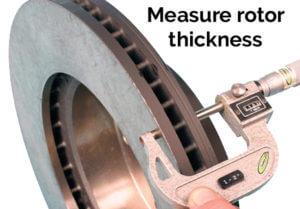 use a brake micrometer to measure the rotor’s current thickness. No eyeballing allowed. In order to be a candidate for resurfacing, the rotor must exceed discard thickness by at least 0.015-in. That’s called “machine to” thickness (discard thickness plus 0.015-in.). The machine-to thickness is calculated to leave enough metal on the rotor after resurfacing to allow for
use a brake micrometer to measure the rotor’s current thickness. No eyeballing allowed. In order to be a candidate for resurfacing, the rotor must exceed discard thickness by at least 0.015-in. That’s called “machine to” thickness (discard thickness plus 0.015-in.). The machine-to thickness is calculated to leave enough metal on the rotor after resurfacing to allow for 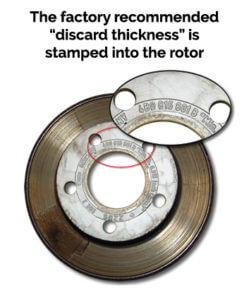 enough rotor wear following the resurfacing to ensure the rotor does not fall below discard thickness during the life of the new brake pads. If the rotor measures at or above machine-to thickness, then it might be a candidate for resurfacing, but only if it passes these other tests. If the rotor doesn’t meet that thickness it must be discarded.
enough rotor wear following the resurfacing to ensure the rotor does not fall below discard thickness during the life of the new brake pads. If the rotor measures at or above machine-to thickness, then it might be a candidate for resurfacing, but only if it passes these other tests. If the rotor doesn’t meet that thickness it must be discarded.
Step 2: Measure brake rotor groove depth
Brake rotors are exposed to road dirt and grit and that grit can become trapped between the brake pad and rotor, causing the grit to wear grooves into the face of the rotor. A rotor with minor scoring can be reused as-is. 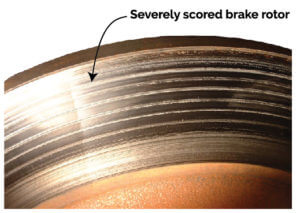 However, if the groove depth reaches 0.060-in. it must be resurfaced or replaced. To be a candidate for resurfacing, the technician must calculate how much rotor material must be removed to level the rotor face and remove the grooves, while still meeting the machine to thickness. If the rotor won’t be thick enough after resurfacing, it must be replaced.
However, if the groove depth reaches 0.060-in. it must be resurfaced or replaced. To be a candidate for resurfacing, the technician must calculate how much rotor material must be removed to level the rotor face and remove the grooves, while still meeting the machine to thickness. If the rotor won’t be thick enough after resurfacing, it must be replaced.
Step 3: Measure disc thickness variation and parallelism
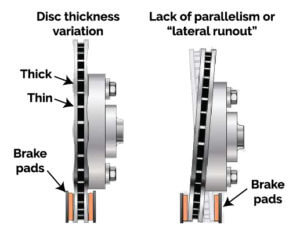 Improper lug nut tightening, sloppy brake installation, road impacts, and rust buildup on the wheel hub can cause a rotor to develop thickness variations and parallelism problems. If a rotor has these issues, the technician must calculate whether there will be enough remaining thickness to justify resurfacing.
Improper lug nut tightening, sloppy brake installation, road impacts, and rust buildup on the wheel hub can cause a rotor to develop thickness variations and parallelism problems. If a rotor has these issues, the technician must calculate whether there will be enough remaining thickness to justify resurfacing.
If the technician makes all these measurements and determines the rotor will have enough metal remaining after resurfacing to meet the machine-to specification, then you can consider resurfacing as long as the shop uses an “on-car” brake lathe.
Step 4: Examine the condition of the rotor cooling vanes
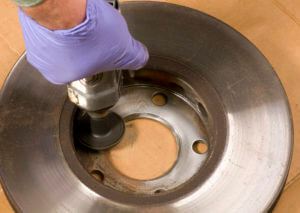 Rotors rust and some of that rust can greatly
Rotors rust and some of that rust can greatly 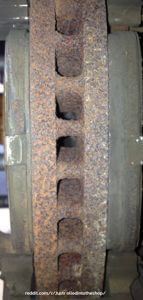 affect the rotor’s ability to dissipate heat. The most critical areas are inside the cooling vanes and the mating area where the rotor meets the wheel hub. If the cooling vanes are clogged with rust scale, it must be removed and that can be labor-intensive to the point of making it uneconomical.
affect the rotor’s ability to dissipate heat. The most critical areas are inside the cooling vanes and the mating area where the rotor meets the wheel hub. If the cooling vanes are clogged with rust scale, it must be removed and that can be labor-intensive to the point of making it uneconomical.
Step 5: Consider the costs of resurfacing versus replacement
The labor required to resurface a brake rotor using an on-car brake lathe can often cost more than a brand new brake rotor. Resurfacing a rotor takes three separate steps: rough cut, fine cut, 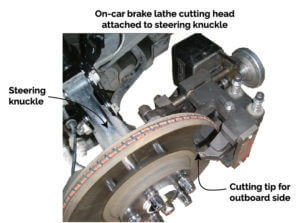 non-directional finish application. It takes about 30- mins per rotor to install the on-car brake lathe and perform the resurfacing procedure. If the shop charges $100/hr. and brand new rotors cost $50 each (2 required per brake job), you’re better off replacing the rotors as long as the shop will be using professional grade name brand rotors. See this article on brake rotors
non-directional finish application. It takes about 30- mins per rotor to install the on-car brake lathe and perform the resurfacing procedure. If the shop charges $100/hr. and brand new rotors cost $50 each (2 required per brake job), you’re better off replacing the rotors as long as the shop will be using professional grade name brand rotors. See this article on brake rotors
Step 6: Consider the brake noise issue
Shops generally don’t like to reuse old rotors with new pads because they develop noise issues and cause customer comebacks. The noise is caused because the new pads don’t sit perfectly flat against the old rotor. They have “wear in” to the rotor. You may think your old rotor is perfectly flat, but it isn’t on a microscopic level. In fact, it may take months of driving to get the new pads to wear in and quiet down. Are you willing to put up with brake noise that whole time? If not, replace the rotors when you replace the pads.
©, 2016 Rick Muscoplat
Posted on by Rick Muscoplat
